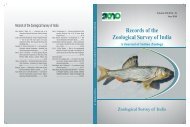Vol. 111 - Part I - Zoological Survey of India
Vol. 111 - Part I - Zoological Survey of India
Vol. 111 - Part I - Zoological Survey of India
You also want an ePaper? Increase the reach of your titles
YUMPU automatically turns print PDFs into web optimized ePapers that Google loves.
78 Rec. zool. Surv. <strong>India</strong><br />
Table : 1. TL : Total length, 1 st DFH : 1 st Dorsal fin<br />
height, PcL : Pectoral fin length, T : Tail length, 2nd DFB : 2 nd Dorsal fin base, PDD : Pre dorsal distance,<br />
ED : Eye diameter, SL : Standard length, 2 nd DFH : 2 nd<br />
Dorsal fin height, A F L : Anal fin length, PcFB : Pectoral<br />
fin base, AFB : Anal fin base HL : Head length.<br />
Distribution : The fishes are distributed widely in<br />
Bay <strong>of</strong> Bengal, East and west China, Great Barrier Reef,<br />
Gulf <strong>of</strong> Thailand, Hong Kong, <strong>India</strong>n Ocean, Indonesian<br />
Sea, Indo-West Pacific, Southern Japan and North W est<br />
Australia to Papua New Guinea, Malaysia and Taiwan<br />
and other parts <strong>of</strong> the world (http://<br />
w w w.zipcodezoo.com).<br />
Remarks : Monacanthidae fishes are very common<br />
in coastal and reef waters <strong>of</strong> <strong>India</strong>n and W estern Pacific<br />
Ocean. Paramonacanthus japonicus was reported first<br />
time from the Gulf <strong>of</strong> Mannar region <strong>of</strong> <strong>India</strong>n waters<br />
by Senthil Kumar (2001). This species inhibits the<br />
vicinity <strong>of</strong> reef environment, hide themselves among<br />
various plants or attached with animals (Mohasin and<br />
Ambak 1996). It feeds on wide variety <strong>of</strong> benthic<br />
invertebrates, corals or zooplankton (http://<br />
w w w.fishbase.com; Masuda et al ., 1984).<br />
Madhavanpillai (1971) reported in his study, on the<br />
occurrence <strong>of</strong> juvenile P. choirocephalus in the Gulf <strong>of</strong><br />
Mannar area especially in the reef region. In another<br />
study conducted by Masuda et al. (1984) reported that<br />
the juveniles some times move towards the seaweed<br />
and sea grass beds in shallow water region. The<br />
moderate salinity <strong>of</strong> the estuarine water and the<br />
abundance <strong>of</strong> coastal vegetation, particularly mangrove<br />
may be the possible regions <strong>of</strong> this fish into the estuary.<br />
ACKNOWLEDGMENTS<br />
The authors are thankful to the Dean <strong>of</strong> this centre<br />
and the authorities <strong>of</strong> Annamalai University for facilities<br />
and the Ministry <strong>of</strong> Environment and Forests, New<br />
Delhi for financial support.<br />
REFERENCES<br />
Fishbase. 2008. A global information system on fishes. A vailable at http://www.fishbase.com/Summary species<br />
Summary. ID=7977 Paramonacanthus japonicus.<br />
Madhavanpillai, P. K., 1971. Juvenile stages <strong>of</strong> a file-fish assign to Paramonacanthus choirocephalus. Ind. J.<br />
fish., 18 (1&2) pp184-186.<br />
Masuda, H., Amaoka, K., Araga, C., Uyeno, T., Y oshino, T., 1984. The fishes <strong>of</strong> the Japanese Archipelago. <strong>Vol</strong>. 1<br />
(text). Tokai University Press, Tokyo, Japan. 437 p. (text), 370 pls.<br />
Mohsin, A. K. M., Ambak, M. A., Salam, M. N. A., 1993. Malay, English, and scientific names <strong>of</strong> the fishes <strong>of</strong><br />
Malaysia. Faculty <strong>of</strong> Fisheries and Marine Science, Universiti Pertanian Malaysia press, serdang, pp 743.<br />
Rao, D. V., 2003. Guide to reef fishes <strong>of</strong> Andaman and Nicobar Islands, zoological survey <strong>of</strong> <strong>India</strong> publication, pp<br />
555.<br />
Senthilkumar, R., 2001. Systematic, biochemical and toxinology <strong>of</strong> tetradontid fishes (Pisces: Tetradontidaeformes)<br />
<strong>of</strong> South coast <strong>of</strong> <strong>India</strong>. Ph.D thesis CAS in Marine Biology, Annamalai University, <strong>India</strong>, pp 139.<br />
Zipcodezoo. 2008. http://www.zipcodezoo.com/Animals/Paramonacanthus japonicus.<br />
Fig. 1. Paramonacanthus japonicas.<br />
Fig. 2. Color changing behavior <strong>of</strong> fish Paramonacanthus<br />
japonicas in the rearing tank.
















